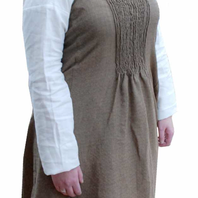
Viking Objects
Reproduction Women’s Clothing Set
The woollen strap-overdress is brown broken-diamond twill. A complete example of this dress has never been found, but this reconstruction is based on a composite of known archaeological finds. The narrow straps are often found mineralised inside the brooches, the pleated front section is based on an archaeological find from Køstrup, in Denmark, and the asymmetrical back panels are based on an original find from Hedeby, in Denmark. The underdress is of bleached linen, based largely on small traces of archaeological material from Birka, Sweden, Dura, Finland, and contemporary depictions. The woollen cloak is of thick yellow diamond twill with fringed edge. The vegetable-tanned leather toggled turnshoes are based on originals found during excavations at Coppergate, in York.
Read More
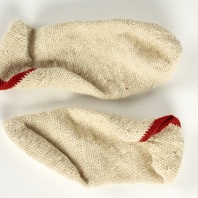
Viking Objects
Reproduction Socks
A pair of reproduction woollen socks based on one found at Coppergate, York. The socks are made using a technique called nålbinding.
Read More
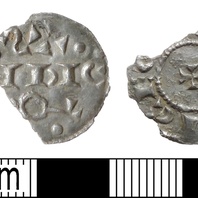
Viking Objects
Incomplete Viking Silver Penny (DENO-7A0AF7)
An incomplete silver early medieval penny of the Vikings influenced by the Swordless St Peter type and possibly minted in the name of Sihtric Caoch who ruled Dublin between 917-920 CE and was King of Northumbria from 921-927 CE. It is not certain why he left Ireland. The Irish annals state that it was ‘through the grace of God’ and do not elaborate on the politics behind his departure. After the establishment of the Danelaw, some Viking leaders decided to mint their own coins to solidify their legitimacy in the eyes of the local populace. This created a hybrid economy where some members of the Danelaw used bullion and others used coins.
Read More
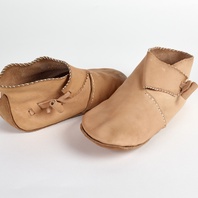
Viking Objects
Reproduction Shoes
A pair of leather turnshoes based on examples found at Coppergate, York. The shoes are vegetable tanned and fastened by a toggle on the side.
Read More
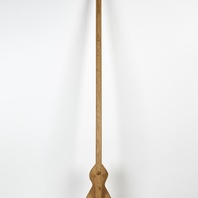
Viking Objects
Reproduction Shovel
A reproduction wooden shovel based on fragments found at York.
Read More
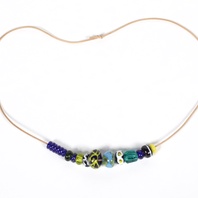
Viking Objects
Reproduction York Glass Beads
This necklace with glass beads is based on originals from York. Glass beads were a coveted item with some being imported from as far away as the Middle East. They were manufactured by specialised artisans who would heat various coloured glass rods over a furnace and melt the glass onto a metal stick to form different shaped beads.
Read More
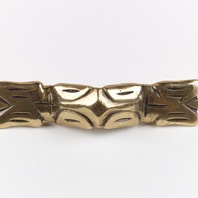
Viking Objects
Reproduction Ansate Brooch
A reproduction, copper alloy, ansate brooch based on an example from York. Two copper alloy examples of ansate brooches, also known as equal-armed brooches, were found at 16-22 Coppergate. These brooches are characterised by a narrow arched bow and terminal heads of identical form. The design of the brooches from Coppergate are a variant known as ‘caterpillar’ type. Asnate brooches are dated to between the seventh and ninth centuries though the finds at Coppergate may extend their popularity into the tenth century. The ‘caterpillar’ variety is typically geographically limited to areas bordering the North Sea. The quantity found in England, however, may indicate local manufacture. Brooches were a typical part of female dress. Scandinavian brooches came in a variety of sizes and shapes which included disc, trefoil, lozenge, equal-armed, and oval shapes. The different brooch types served a variety of functions in Scandinavian female dress with oval brooches typically being used as shoulder clasps for apron-type dresses and the rest being used to secure an outer garment to an inner shift. Anglo-Saxon brooches do not match this diversity of form with large disc brooches being typical of ninth century dress styles with smaller ones becoming more popular in the later ninth and tenth centuries. However, since disc brooches were used by both Anglo-Saxon and Scandinavian women they are distinguished by their morphology. Scandinavian brooches were typically domed with a hollow back while Anglo-Saxon brooches were usually flat. Moreover, Anglo-Saxon brooches were worn singly without accompanying accessories.
Read More
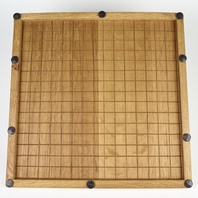
Viking Objects
Reproduction Game Board
A reproduction oak game board based on one from Coppergate, York. This is a larger-than-usual hnefatafl board with no significant squares marked out. Gaming pieces have been laid out on it in some of the photographs, but it is likely that a board this size would require more pieces on the outer edges (the attackers).
Read More
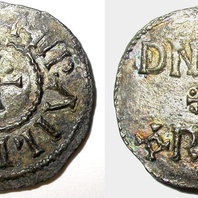
Viking Objects
Viking York Penny (1995-17)
This silver penny was found during demolition work at St Alkmund’s Church in 1967. This type was minted at York for the rulers Sigeferth and Cnut, but this coin has no names, whether of a ruler, a moneyer or a mint. Sigeferth is recorded as being a pirate in Northumbria around 893 and seems to have assumed control after Guthfrith’s death in 895. Cnut is not attested in written sources but Scandinavian tradition places him in Northumbria around the same time. The joint Sigeferth Cnut coins and the sole issues of Cnut were minted around c. 900. This type of penny is known as Mirabilia Fecit from the Latin Cantate Dominum canticum novum, quia mirabilia fecit. Mirabilia fecit means ‘he made it marvellously’ and is the inscription on one side of the coin while the other has the inscription DNS DS REX (‘Dominus Deus rex’ = ‘the lord God almighty is king’).
Read More
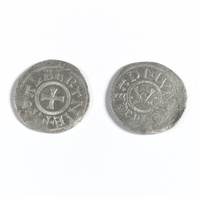
Viking Objects
Reproduction Viking Silver Penny
This reproduction of a Viking silver penny immitates those minited bu the Vikign rulers of York in the tenth century. Viking rulers in the Danelaw eventually took up the Anglo-Saxon practice of minting coins which helped legitimise their authority.
